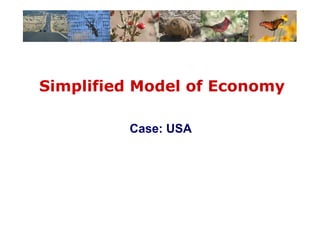
Economy Model
- 1. Simplified Model of Economy Case: USA
- 2. Capital Value of Foreign Influx Trade Deficit receivables Debt Interest rates Debt Inflation 70% Savings Consumption Investment Demand Prices Jobs Manufacturing Imports -oil Exports -goods USD/€ Costs Profits USD/RMB $ 6,- / h $ 1,60 => 2,- / $ 5,77 => 7,21 / h Tax Value of Income Reserves
- 3. Printing money The Central Bank is printing dollars and US bonds. The Secretary of State Mrs. Clinton is rallying around the globe to promote the sales of the bonds to secure the inflow of dollars to finance the deficits. This seems to work for the moment. The path for lower external value of USD will get prepared. The USD must get devaluated against other currencies in order to let US economy to heal towards a trade balance on the long run. It is obvious that an ever deeper trade deficit and foreign debt cannot be sustained forever. The biggest hurdle might be found in the USD/Yuan exchange rate. The Chinese government will control the value of Yuan (reminbin) against USD in order to guarantee the continuation of the status of China as the number one manufacturing location in the world.
- 4. Receivables & Reserves China hasn’t downgraded its receivables from the USA yet. That’s because the USD has been so heavily weighted in the currency basket of Yuan. When the external value of USD drops the PRC, banks and other Chinese lenders must correct the value of their assets down. That would mean huge losses in hundreds of millions or even billions of USD, and that they are trying to avoid now. China has demanded USA to hold the external value of the USD. However, this will become a task or mission impossible in the near future. When USD looses its external value there is a risk of inflation because imported goods and service will cost more by then – like oil, gas, and other imported goods etc..
- 5. Generating Jobs Like stated in prior blogs the USA needs jobs, stability, trade balance and therefore growth. The growth is guaranteed by growing population, but it must be able to consume. That is not possible without jobs and a strong middle class. The Jobs are created by small and mid-size companies mainly. They must be able to produce, make, trade and especially sell their products in order to hire and make investing decisions. Because the US economy is about 70% driven by inland consumption the FED cannot increase the interest rates too much – even if the inflation would pick up a bit. Now, I think the demand for goods and service is best generated in the USA by low external value of USD. And this devaluation untraditionally not because of increasing the exports but to make returning of manufacturing possible!
- 6. USD / RMB What is that? US based corporations have outsourced and tranfered manufacturing to low-cost countries (LCC) like China, India, Vietnam etc. Now, when the external value of USD goes down, the gap – cost difference – gets smaller between manufacturing costs in LCC (or other countries) and the USA. When taking into consideration the level of minimum wage of $ 6,- per hour in the USA (equals to 4,2 € per hour). At China’s west coast an average worker gets around $ 1,10 to $ 1,60 per hour in a Chinese owned company and up to $ 5,77 in a foreign owned company. There is still a difference, but that is not the case when counting with total landed costs. Depending on the product the freight, handling, export and import related costs like duties and taxes come on top of that. We might estimate that around 25% must get added to the cost – material cost is seen here as a constant factor and therefore not considered. By doing like this $ 1,60 gets to $2,- and $ 5,77 gets even to $ 7,21.When the exchange rate of USD drops against Yuan this gap gets narrower. When USD / Yuan ratio changes 30- 40% then the remaining gap is only 6-2,80 = $ 3,20 per hour for manufacturing in real Chinese company and negative $ 1,21 in a western company. The final outcome would be that manufacturing in the USA would make sense again.
- 7. The USA will boom When US corporations start to bring manufacturing back home, a boom in investing, job creation, and growth will happen. The middle class begins to feel right, federal income would rise, and even foreign companies would begin to invest heavily in the USA. The nation would prosper again and easily pay back the foreign debt. The trade balance would get positive when imports drop and remain on a lower level. Inflation would go up and therefore also the interest rates, but that would be ok, when the whole world invests and believes in the USA again.
